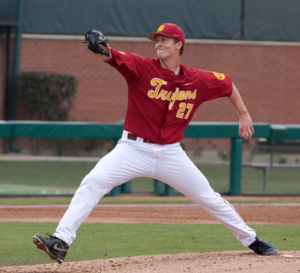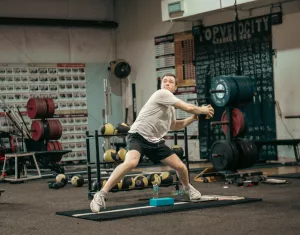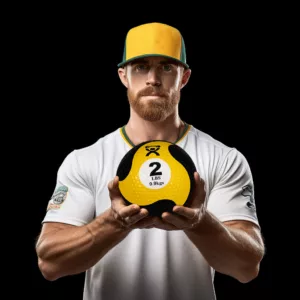Are you a pitching athlete looking to increase your velocity? If so, then you've probably heard the words rotational power long before today. The idea behind it is that the more rotation of the body and hips can effectively add speed and accuracy to each pitch. While this does have some merit, overly relying on rotational power when making pitches will actually lead to injury for an athlete. Healthy power pitching requires optimal hip to shoulder separation a critical component to the pitching delivery that produces stronger throws without compromising safety or overall performance. This article will endeavor to explain how players who were upper-body or "axial rotation dominate" were at a much greater risk of injury when compared to those who optimized their kinetic sequence and took advantage of ground reaction force to enhance their hip rotation. Stay with me till the end and I will show you the secret to how you can develop a healthy power pitch.
Understanding the Difference Between Healthy Power Pitching and Rotational Power

A healthy and sustainable pitching delivery generates power through proper sequencing of the kinetic chain rather than relying on torque or rotational forces in the shoulder and elbow. Baseball pitchers who use their whole body to channel the ground reaction forces efficiently by driving forward off the rubber and finishing balanced over their front side, are able to maintain velocity and control deep into games and seasons. In contrast, pitchers who are quick to fly open cannot efficiently channel ground reaction forces up the kinetic chain. To make up for the loss in velocity from poor lower half coordination, pitchers become overly rotational and place unneeded or wanted stress on their upper body. By properly evaluating a pitcher's delivery and the effortlessness of his velocity is just as important as the raw numbers on the scoreboard. Proper mechanics and athleticism will lead to long term success over dangerous contortions for short term gains.
The Importance of Proper Pitching Mechanics When it Comes to Power Pitching
Proper pitching mechanics are crucial for power pitchers to reach maximum velocity and avoid injury. When pitching, the kinetic chain of energy starts at the first point of contact with the rubber. From the ankle up through the leg and hips, which transfers energy through the core and shoulders, and ends at ball release from the hand. If any part of the chain is out of sync or misaligned, velocity and control suffer. Power pitchers must maintain balance and posture over their back leg to generate force, rotate hips and shoulders ahead of arm motion, and release the ball with a straight follow through for optimal velocity and accuracy. While natural ability plays some role, consistent refinement of mechanics is how pitchers unlock and harness the power in their delivery. With solid pitching mechanics and relentless practice, pitchers can reach their full potential as healthy power pitchers and dominate on the mound.
Core Strength for Healthy Pitching Velocity
 To increase pitching velocity, focusing on core strength is key. A strong core serves as the foundation for power and speed in pitching. When the core muscles in the abdomen and lower back are strengthened through conditioning exercises, they provide more stability and force to propel the arm during the pitching motion. A combination of med-ball drills and a dedicated workout program with direct core training included at least 2-3 times a week will help develop your core. By consistently working the core 2-3 times a week, pitchers can steadily increase their average pitching velocity and overpower more hitters. Staying dedicated to a core conditioning program, along with full-body strength and pitching mechanics training, can make the difference between an average fastball and a blazing heater.
To increase pitching velocity, focusing on core strength is key. A strong core serves as the foundation for power and speed in pitching. When the core muscles in the abdomen and lower back are strengthened through conditioning exercises, they provide more stability and force to propel the arm during the pitching motion. A combination of med-ball drills and a dedicated workout program with direct core training included at least 2-3 times a week will help develop your core. By consistently working the core 2-3 times a week, pitchers can steadily increase their average pitching velocity and overpower more hitters. Staying dedicated to a core conditioning program, along with full-body strength and pitching mechanics training, can make the difference between an average fastball and a blazing heater.
Why proper posture matters in the pitching delivery
Proper posture is essential for generating maximum velocity and accuracy in a pitching delivery. When a pitcher stands with correct posture—shoulders back, chest open, spine elongated—it allows for a full windup and follow through that harnesses the power of the entire body. If the shoulders are hunched or the back is arched, it limits range of motion and reduces force generation from the legs and core. An effective pitcher understand that developing optimal force in the pitching delivery is a whole-body motion, beginning from the ground up, and it all starts with posture. Maintaining good posture is a habit that pays off with every fastball and strike.
Exercises you can do to Improve Power Pitching Without Sacrificing Mechanics or Health

"To throw faster as a pitcher without hurting your arm, focus on power-building exercises that utilize your whole body. The 3X Pitching Velocity Medicine ball drills are excellent exercises for building power throughout your kinetic chain. These drills force you to utilize your entire body to throw the ball which helps reinforce proper technique. You will know if you are only using your upper body to throw as the ball will not make it far. Young pitchers should start with light weight (1 lb) and high school and above should never go beyond a two-pound capacity.
Plyometric pushups, where you push up so forcefully that your hands leave the ground, help generate power through your chest and triceps. Having a strong, powerful, and explosive upper body will help your body handle more stress that is associated with an increased velocity. Olympic
lifts, squats, lunges, and lateral lunges with weights help strengthen your legs to give you a stronger base and more leg drive toward the plate. These full-body power exercises, when performed consistently and properly, can increase your pitching velocity and make your fastball even more formidable, all while maintaining sound pitching mechanics and arm health."
Tips for maintaining good form and technique during each pitch
To maximize pitching velocity and accuracy, it is critical to maintain consistent technique with each pitch. As the pitcher goes into his windup and delivery, he should keep his elbow up and close to his body to maintain a straight throwing path to the target. Striding forward with momentum and pushing off the rubber with a strong leg drive are essential to generating speed and power. Following through after releasing the ball, with the throwing arm finishing high and the stride leg landing toward home plate, helps ensure that pitches are thrown with tight spin and command. By repeating the proper mechanics pitch after pitch, a pitcher gives himself the best opportunity to overpower any hitter and retire batters efficiently.
Becoming a healthy power pitcher takes hard work and dedication, but with dedication your efforts will pay off. With the correct mechanics, methodical exercise routine and proper technique, you can become not only a healthier baseball player but faster on the mound as well. Try focusing on core strength during each exercise and emphasizing proper posture with every pitch. Don’t forget to prioritize good form--focus on increasing velocity without sacrificing your mechanics or health. With these tips in mind, you are sure to take your pitching velocity to a new level and gain a significant advantage on the mound!
Optimizing Energy Transfer: The Link Between Joint Loading Efficiency and Pitching Success
In conclusion, it is evident that healthy power pitching is not primarily rotational but relies on optimizing the kinetic chain. The prevention of injuries such as rotator cuff tears or UCL tears is of utmost importance for pitchers. By enhancing the energy transfer from the back leg throughout the body, pitchers can effectively decrease the stress on their shoulder and elbow joints for each mph of velocity increased. This not only allows pitchers to throw faster but also significantly reduces the risk of injury. Furthermore, the benefits extend to the longevity of a pitcher's career, as improved joint loading efficiency enables sustained high-performance levels over an extended period. Coaches and athletes alike should prioritize training techniques that enhance the energy generated by the drive leg, thereby maximizing pitching velocity and promoting superior joint loading efficiency. By doing so, pitchers can optimize their performance while safeguarding their long-term health.
#1 off season training and in season training program for baseball players

At Top Velocity, we understand the importance of ground reaction force in generating explosive pitching velocity. Our expert coaches will teach you how to optimize your lower body mechanics, utilizing the ground as a powerful force to propel your pitches with increased speed and efficiency. You will learn the proper techniques for generating maximum force from your back foot, resulting in enhanced energy transfer up the kinetic chain and improved overall pitching performance.
In addition, our camp places a strong emphasis on hip to shoulder separation, a critical factor in developing elite-level pitching skills. Our knowledgeable instructors will guide you through targeted exercises and drills designed to increase your shoulder mobility and separation, allowing you to generate greater torque and power during your delivery. By mastering these key components of pitching mechanics, you'll experience enhanced velocity, better command, and reduced risk of arm injuries.
Don't miss out on this incredible opportunity to elevate your game. Join the Top Velocity 3X Pitching Velocity Camp today and unlock your full potential as a pitcher. Whether you're a beginner looking to establish a strong foundation or an advanced player seeking to refine your skills, our camp offers personalized instruction tailored to your needs. Sign up now and get ready to unleash your full pitching potential!

Helpful Studies on the Kinetic chain
Role of Pelvis and Trunk Biomechanics in Generating Ball Velocity in Baseball Pitching
Association of Pitch Timing and Throwing Arm Kinetics in High School and Professional Pitchers

